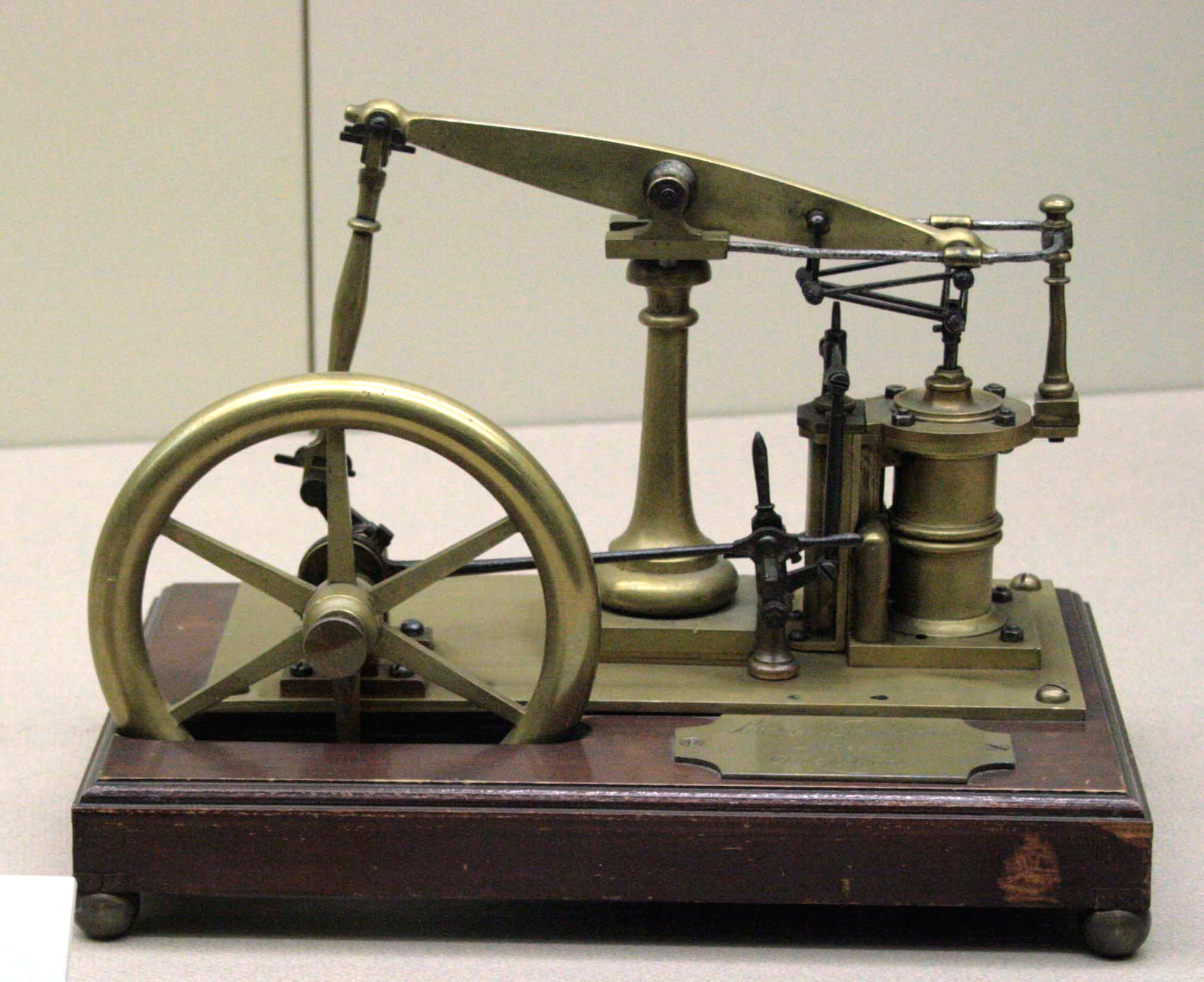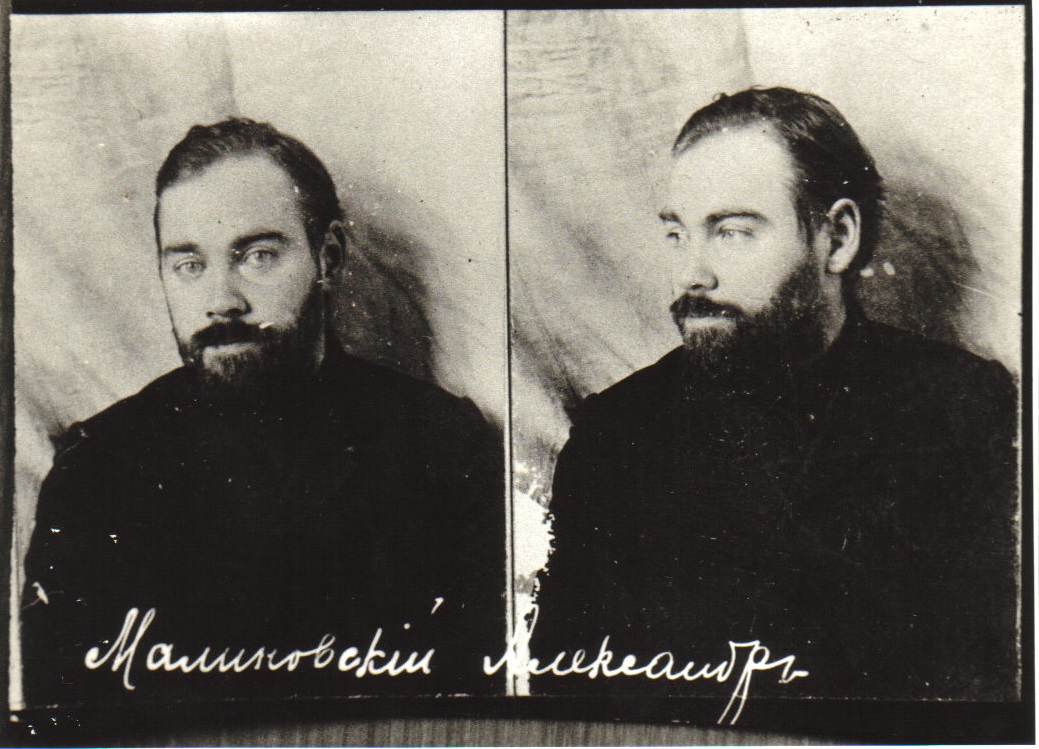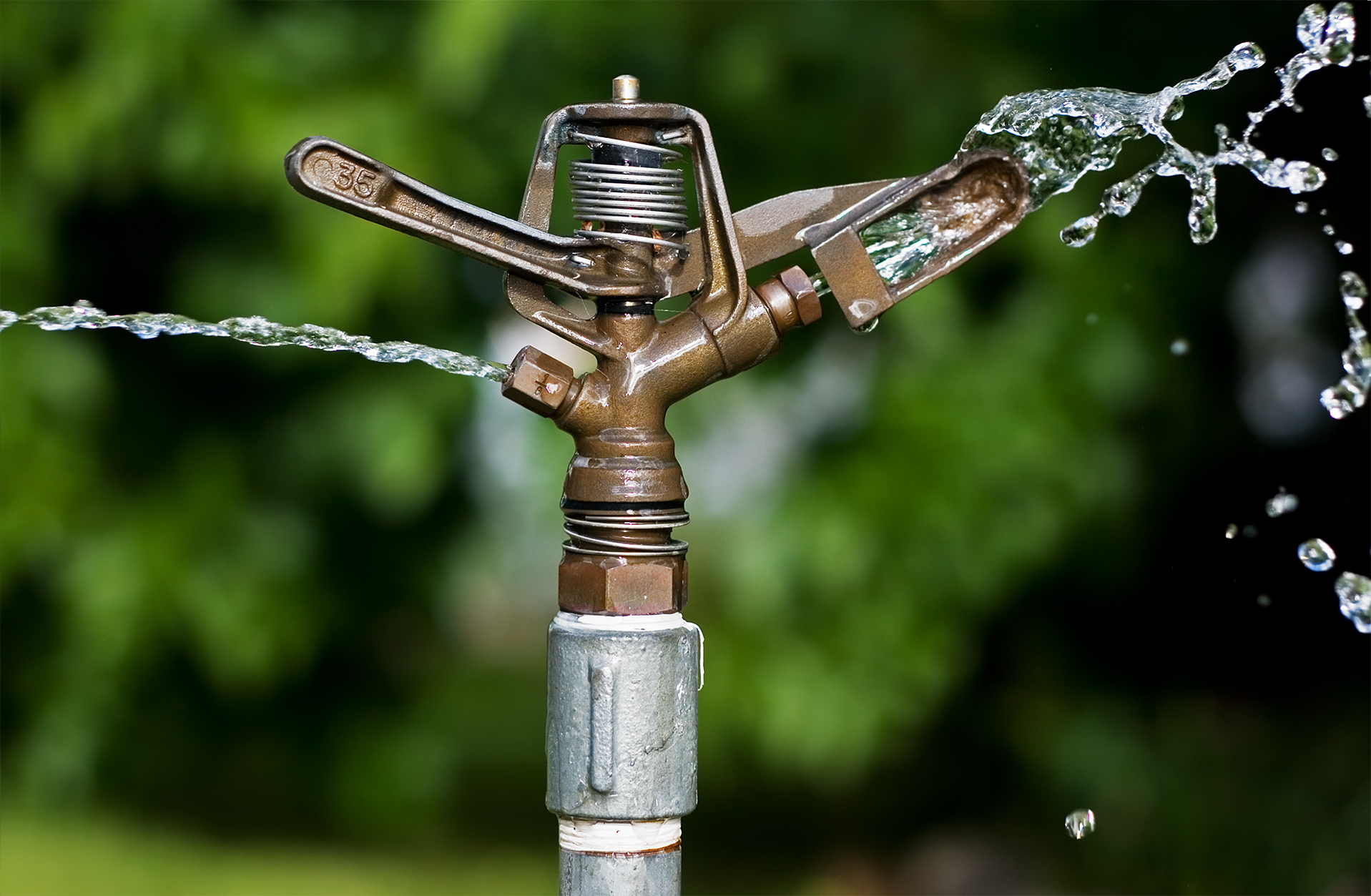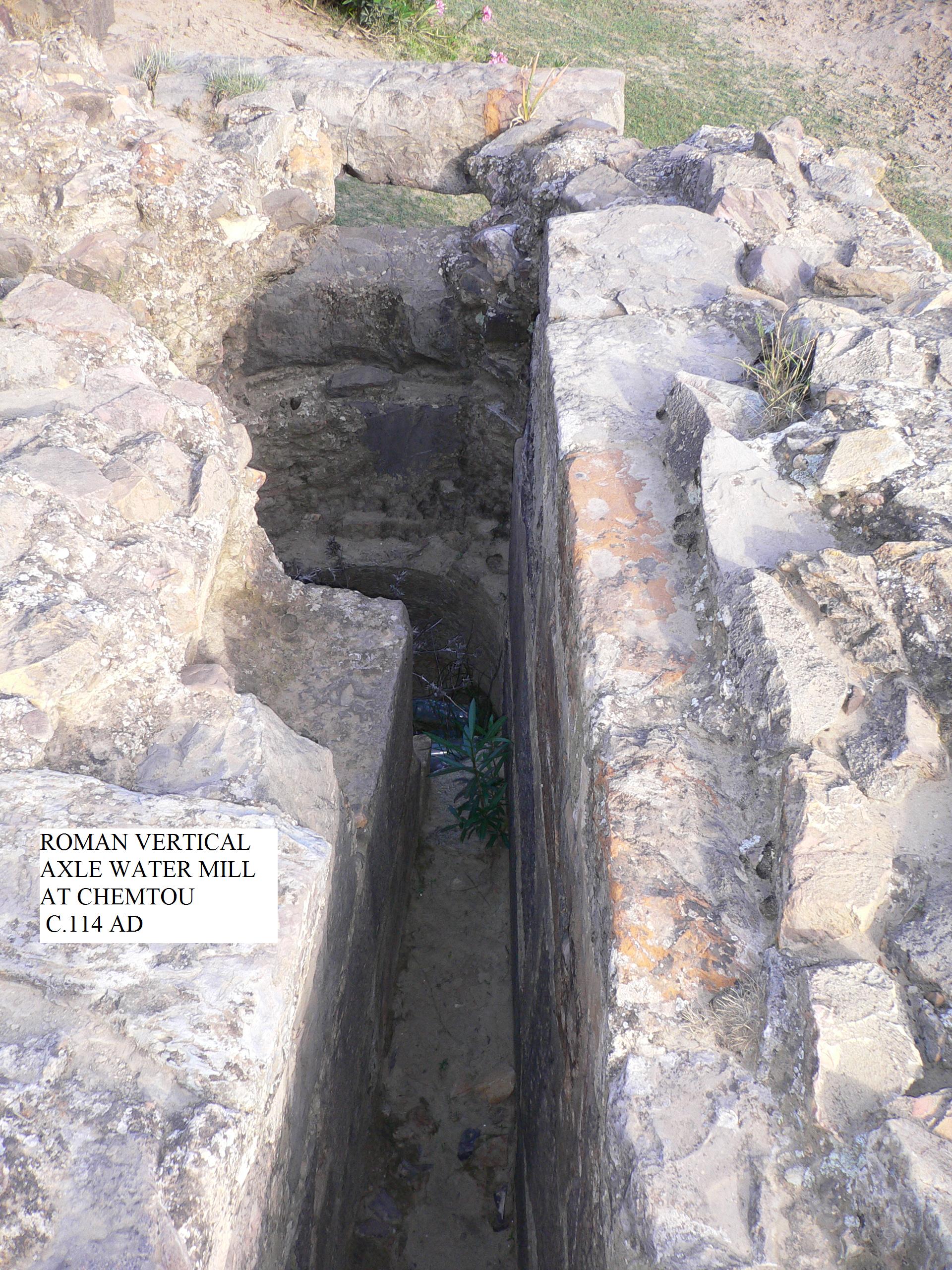|
Segner Wheel
The Segner wheel or Segner turbine is a type of water turbine invented by Johann Andreas Segner in the 18th century. It uses the same principle as Hero's aeolipile. The device is placed in a suitable hole in the ground (or at the slope of a hill). The water is delivered to the top of a vertical cylinder, at the bottom of which is a rotor with specially bent pipes with nozzles (see image). Due to the hydrostatic pressure, the water is ejected from the nozzles, causing the rotor to rotate. The useful torque is transferred to a powered device through a belt and pulley system. Segner turbines, also called reaction or Scotch turbines, were built in the mid-1850s to power the inclined plane lifts along the Morris Canal in New Jersey. Today, the Segner wheel principle is used in irrigation sprinklers. Alexander Bogdanov cited this an example of an important innovation which paved the way for the development of steam engines. The turbine at Museo Hacienda Buena Vista is "the only p ... [...More Info...] [...Related Items...] OR: [Wikipedia] [Google] [Baidu] [Amazon] |
Segner Turbine , type of water turbine invented by Ján Andrej Segner in the 18th century
{{disambiguation ...
Segner may refer to: * 28878 Segner (2000 KL41), a Main-belt Asteroid discovered in 2000 *Johann Andreas Segner (1704–1777), Carpatho-German mathematician, physicist, and physician *Segner (crater), lunar crater located northeast of the giant walled plain Bailly *Segner wheel The Segner wheel or Segner turbine is a type of water turbine invented by Johann Andreas Segner in the 18th century. It uses the same principle as Hero's aeolipile. The device is placed in a suitable hole in the ground (or at the slope of a hil ... [...More Info...] [...Related Items...] OR: [Wikipedia] [Google] [Baidu] [Amazon] |
Morris Canal
The Morris Canal (1829–1924) was a toll road, common carrier Anthracite, anthracite coal canal across North Jersey, northern New Jersey that connected the two industrial canals in Easton, Pennsylvania across the Delaware River from its western terminus at Phillipsburg, New Jersey to New York Harbor and New York City through its eastern terminals in Newark, New Jersey, Newark and on the Hudson River in Jersey City, New Jersey, Jersey City. The canal was sometimes called the Morris and Essex Canal, in error, due to confusion with the nearby and unrelated Morris and Essex Railroad. With a total elevation change of more than , the canal was considered an ingenious technological marvel for its use of hydropower, water-driven Canal inclined plane, inclined planes, the first in the United States, to cross the northern New Jersey hills. It was built primarily to move coal to industrializing eastern cities that had stripped their environs of wood. Completed to Newark in 1831, the can ... [...More Info...] [...Related Items...] OR: [Wikipedia] [Google] [Baidu] [Amazon] |
Lake Hopatcong
Lake Hopatcong is the largest freshwater body in New Jersey, United States, about in area. Located from the Delaware River and from Manhattan, New York City, the lake forms part of the border between Sussex County, New Jersey, Sussex and Morris County, New Jersey, Morris counties in the state's New Jersey Highlands, northern highlands region. Lake Hopatcong was produced by damming and flooding of two ponds, known as the Great Pond and Little Pond, and the Musconetcong River, its natural outlet. Historically known as a resort lake for vacationing New Yorkers, it is now a mostly suburban residential lake. Name The exact origin of the name Hopatcong is unknown, though it is most commonly attributed to the Lenape Indian word for "stone water," or "stone over water". Some linguists believe "Hopatcong" to be a derivative of the Lenape word ''hapakonoesson'', meaning "pipe stone". One explanation of the origin of the word ''Hopatcong'' is that it was a derivation from the Lenni Lena ... [...More Info...] [...Related Items...] OR: [Wikipedia] [Google] [Baidu] [Amazon] |
Hopatcong State Park
Hopatcong State Park is a state park in the Landing section of Roxbury Township, New Jersey, United States. Operated and maintained by the New Jersey Division of Parks and Forestry, the park consists of two parcels of land: one that encompasses Lake Hopatcong and some of its southwestern shore, and another that encompasses Lake Musconetcong about one mile to the west-southwest. The park contains remnants of Morris Canal, which operated from the 1830s to the 1920s and was largely fed by the lake. The park is also home to the Lake Hopatcong Historical Museum, housed in the former home of the lock tender and his family. Activities Swimming is permitted in the park from Memorial Day through Labor Day while lifeguards are on duty. Subject to NJDEP regulations, there is year-round fishing at Lake Hopatcong and Lake Musconetcong, which are stocked by New Jersey Division of Fish and Wildlife stocks them with brown trout, rainbow trout and brook trout. Commonly caught warmwater spec ... [...More Info...] [...Related Items...] OR: [Wikipedia] [Google] [Baidu] [Amazon] |
Ledgewood, New Jersey
Ledgewood is an unincorporated community and census-designated place (CDP) in Roxbury Township, Morris County, New Jersey, United States. It was historically known as Drakesville after Abraham Drake, originally from Piscataway, New Jersey, who operated a mill and tavern here in the mid-1700s. The community was located on the Morris Canal. The name changed to Ledgewood on January 1, 1892. The area is served as United States Postal Service ZIP Code 07852. As of the 2020 census, the population was 4,903. Geography Ledgewood is in western Morris County, in the western part of Roxbury Township. The CDP is bordered to the north by Landing, to the northeast by the borough of Mount Arlington, to the east by Kenvil, and to the south by Succasunna. It is bordered to the west by Flanders and Budd Lake within Mount Olive Township. The borough of Netcong is less than north of the northwest corner of Ledgewood. The unincorporated community of Ledgewood is in the eastern part of ... [...More Info...] [...Related Items...] OR: [Wikipedia] [Google] [Baidu] [Amazon] |
Museo Hacienda Buena Vista
Museo Hacienda Buena Vista is a historic coffee plantation farm museum in Barrio Magueyes, Ponce, Puerto Rico. The museum opened in 1987, and receives some 40,000 visitors a year.''Con taller de catación: Salda prolífico año Hacienda Buena Vista.'' Gary Gutiérrez. La Perla del Sur. Ponce, Puerto Rico. Week of 3–10 November 2010. Obsolete link updated 24 January 2019. The museum has been described as "Puerto Rico's first living museum of art and science." The original plantation belonged to the Vives family and dates from the 19th century. The structures and land are now owned by the ''Fideicomiso de Conservación'' (Puert ... [...More Info...] [...Related Items...] OR: [Wikipedia] [Google] [Baidu] [Amazon] |
Steam Engines
A steam engine is a heat engine that performs Work (physics), mechanical work using steam as its working fluid. The steam engine uses the force produced by steam pressure to push a piston back and forth inside a Cylinder (locomotive), cylinder. This pushing force can be transformed by a connecting rod and Crank (mechanism), crank into rotational force for work. The term "steam engine" is most commonly applied to reciprocating engines as just described, although some authorities have also referred to the steam turbine and devices such as Hero's aeolipile as "steam engines". The essential feature of steam engines is that they are external combustion engines, where the working fluid is separated from the combustion products. The ideal thermodynamic cycle used to analyze this process is called the Rankine cycle. In general usage, the term ''steam engine'' can refer to either complete steam plants (including Boiler (power generation), boilers etc.), such as railway steam locomot ... [...More Info...] [...Related Items...] OR: [Wikipedia] [Google] [Baidu] [Amazon] |
Alexander Bogdanov
Alexander Aleksandrovich Bogdanov (; – 7 April 1928), born Alexander Malinovsky, was a Russian and later Soviet physician, philosopher, science fiction writer and Bolshevik revolutionary. He was a polymath who pioneered blood transfusion, as well as general systems theory, and made important contributions to cybernetics. He was a key figure in the early history of the Russian Social Democratic Labor Party (later the Communist Party of the Soviet Union), originally established 1898, and of its Bolshevik faction. Bogdanov co-founded the Bolsheviks in 1903, when they split with the Menshevik faction. He was a rival within the Bolsheviks to Vladimir Lenin (1870–1924), until being expelled in 1909 and founding his own faction Vpered. Following the Russian Revolutions of 1917, when the Bolsheviks came to power in the collapsing Russian Republic, he was an influential opponent of the Bolshevik government and Lenin from a Marxist leftist perspective during the first decade of t ... [...More Info...] [...Related Items...] OR: [Wikipedia] [Google] [Baidu] [Amazon] |
Irrigation Sprinkler
An irrigation sprinkler (also known as a water sprinkler or simply a sprinkler) is a device used to irrigate (water) agricultural crops, lawns, landscapes, golf courses, and other areas. They are also used for cooling and for the control of airborne dust. Sprinkler irrigation is the method of applying water in a controlled manner in way similar to rainfall. The water is distributed through a network that may consist of pumps, valves, pipes, and sprinklers. Irrigation sprinklers can be used for residential, industrial, and agricultural usage. It is useful on uneven land where sufficient water is not available as well as on sandy soil. The perpendicular pipes, having rotating nozzles on top, are joined to the main pipeline at regular intervals. When water is pressurized through the main pipe it escapes from the rotating nozzles. It gets sprinkled on the crop. In sprinkler or overhead irrigation, water is piped to one more central locations within the field and distributed by overh ... [...More Info...] [...Related Items...] OR: [Wikipedia] [Google] [Baidu] [Amazon] |
New Jersey
New Jersey is a U.S. state, state located in both the Mid-Atlantic States, Mid-Atlantic and Northeastern United States, Northeastern regions of the United States. Located at the geographic hub of the urban area, heavily urbanized Northeast megalopolis, it is bordered to the northwest, north, and northeast by New York (state), New York State; on its east, southeast, and south by the Atlantic Ocean; on its west by the Delaware River and Pennsylvania; and on its southwest by Delaware Bay and Delaware. At , New Jersey is the List of U.S. states and territories by area, fifth-smallest state in land area. According to a 2024 United States Census Bureau, U.S. Census Bureau estimate, it is the List of U.S. states and territories by population, 11th-most populous state, with over 9.5 million residents, its highest estimated count ever. The state capital is Trenton, New Jersey, Trenton, and the state's most populous city is Newark, New Jersey, Newark. New Jersey is the only U.S. stat ... [...More Info...] [...Related Items...] OR: [Wikipedia] [Google] [Baidu] [Amazon] |
Canal Inclined Plane
An inclined plane is a type of boat lift cable railway used on some canals for raising boats between different water levels. Boats may be conveyed afloat, in caissons, or may be carried in cradles or slings. History Inclined planes have evolved over the centuries. Some of the first were used by the Egyptians to bypass waterfalls on the Nile. These consisted of wooden slides covered with silt which reduced friction. Timeline *600BC – The Diolkos, an early Greek inclined plane, was in use. *385AD – Inclined planes were in use on the Grand Canal in China. *1167 – Nieuwedamme ''overtoom'' (a simple type of incline) was built at Ypres. *1568 – Wagon of Zafosina in use near Venice. *1777 – 3 inclined planes or 'dry wherries' began operation on Dukart's Canal, near Coalisland, in the south-east of County Tyrone in Ulster.''Hadfield's British Canals'' eighth edition Joseph Boughey Page 49 *1788 – An inclined plane was built by William Reynolds and used, for the first ... [...More Info...] [...Related Items...] OR: [Wikipedia] [Google] [Baidu] [Amazon] |
Water Turbine
A water turbine is a rotary machine that converts kinetic energy and potential energy of water into mechanical work. Water turbines were developed in the 19th century and were widely used for industrial power prior to electrical grids. Now, they are mostly used for electric power generation. Water turbines are mostly found in dams to generate electric power from water potential energy. History Water wheels have been used for hundreds of years for industrial power. Their main shortcoming is size, which limits the flow rate and head (hydraulic), head that can be harnessed. The migration from water wheels to modern turbines took about one hundred years. Development occurred during the Industrial Revolution, using scientific principles and methods. They also made extensive use of new materials and manufacturing methods developed at the time. Swirl The word turbine was introduced by the French engineer Claude Burdin in the early 19th century and is derived from the Greek w ... [...More Info...] [...Related Items...] OR: [Wikipedia] [Google] [Baidu] [Amazon] |




